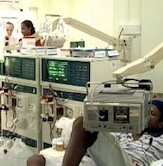
THURSDAY, Jan. 19 (HealthDay News) — Many kidney failure patients experience bleeding in the upper gastrointestinal (GI) tract, a problem that can cause serious health problems and even early death, a new study shows.
The researchers said their findings show that more needs to be done to prevent and treat upper GI bleeding — which occurs in the esophagus, stomach or first part of the intestine — in kidney failure patients.
They noted that kidney failure patients on dialysis are particularly prone to upper GI bleeding.
For this study, the researchers examined data from nearly 1 million patients in the U.S. Renal Data System, which collects information on most of the dialysis patients in the country.
The analysis revealed that rates for upper GI bleeding were either 57 or 328 episodes per 1,000 kidney failure patients per year, according to stringent and lenient definitions of what qualifies as upper GI bleeding. That’s more than 10 times higher than the general population, according to the American Society of Nephrology news release.
The study also found that nearly 12 percent of kidney failure patients who had upper GI bleeding died within a month of bleeding, but there was a significant decline in the death rate from 1998 to 2007.
The death rate fell from a little more than 12 percent in 1998 to 10.5 percent in 2007 according to the stringent definition of upper GI bleeding, and from about 10 percent to 8 percent according to the lenient definition.
Despite that decline — which may be due to improvements in medical care — the dangers of upper GI bleeding in kidney failure patients remain a substantial issue, said the Stanford University School of Medicine researchers and colleagues.
The study appears online Jan. 19 in the Journal of the American Society of Nephrology.
More information
The U.S. National Institute of Diabetes and Digestive and Kidney Diseases has more about bleeding in the digestive tract.
